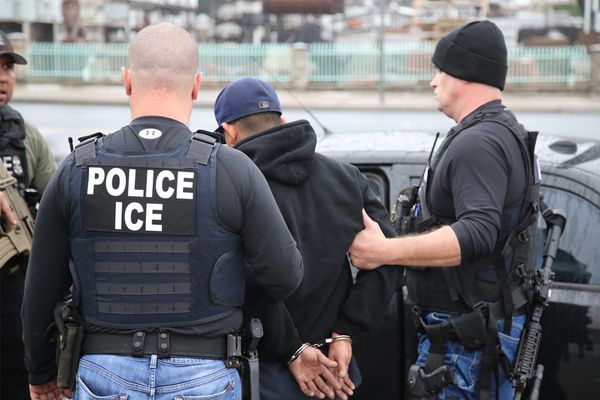
“The operation is not over and it is not ending anytime soon.”
The message from the Department of Homeland Security assistant secretary Tricia McLaughlin went out to Charlotte, North Carolina, on Thursday afternoon, in response to an announcement by Sheriff Garry McFadden that Customs and Border Protection (CBP) was done with its immigration enforcement sweep.
Earlier that day, a CBP spokesperson sent a different note from McLaughlin: “Every day, DHS enforces the laws of the nation across the country. We do not discuss future or potential operations.”
The two statements contradict each other. The sheriff’s statement contradicts the federal government’s statement. But the facts on the ground were easy enough to see.
A network of observers – including the sheriff’s office itself – had been tracking the movement of CBP and Immigration and Custom Enforcement (ICE) agents since they arrived in the Charlotte area last week. Watchers had reported a convoy of federal vehicles moving south on I-85 toward Atlanta before the sheriff’s message went out.
“They want you to feel fear, panic, terror, to not know where the danger is,” said Andrew Willis Garcés, senior strategist with Siembra NC, a grassroots advocacy group for immigrants and Latino communities in the state.
The reaction to immigration enforcement surges varies with the character of the communities. Los Angeles raged against the machine. Portland staged street theater. Washington DC jurors refused to convict people charged with crimes of resistance.
Charlotte has engaged in a bless-their-hearts approach to the surge befitting a city full of bankers who want results while minimizing risks. “Bless your heart” sounds nice, often said in complete sincerity, but widely understood by southerners to be a quiet way to tell someone they’re an idiot when offered in the right context.
People outside of Charlotte’s political power structure have led the resistance in a grassroots movement that left little for Donald Trump to latch on to for formal reprisal. Activists focused on intensifying the discomfort of the agents while mobilizing a wide-ranging early-warning system for their targets that spanned from Tryon Street downtown to the mountain towns of western North Carolina.
Thousands of volunteers had been trained to observe and report on ICE activity in North Carolina even before the announcement of enhanced enforcement, Garcés said. Volunteers shifted focus to neighborhood patrols when CBP arrived, he added.
“How do we get people to work and school safely,” Garcés said. That had been a consistent problem even before the surge. “Every day, basically of the year, there has been early-morning traffic stops, ICE arrests that were where people were going to school or work.”
Activists patrolled neighborhoods where CBP and ICE had been seen operating, following vehicles and at times honking horns in warning. Border patrol agents arrested two women who had been honking horns in a truck behind their own, smashing a window to get at them.
Others documenting CBP and ICE presence at hotels in the region, tracking license plates and car types, going as far as searching Walmart back parking lots looking for early-morning staging areas in the towns surrounding Charlotte and in the Appalachian mountains.
Between the work of groups like Indivisible and Siembra NC, they’ve been able to discern clear patterns in how immigration enforcement operates. Agents would target work vehicles early in the morning, for example, said Garcés of Siembra NC. “It’s actually not out of totally out of our control to know where are these guys hunting people down,” he said. “We can know that and we can also be much more in communication about what we see and where we see.”
When CBP left Charlotte, Siembra NC published video evidence of a 47-vehicle convoy on its way to Atlanta.
In contrast, the city and county government response to the enforcement surge has been muted, with anodyne statements of support for immigrants, and instructions to its entities to minimize cooperation with the federal immigration enforcement surge. McFadden won election on a pledge of noncooperation with ICE.
The cautiousness reflects the political reality in North Carolina, with a near 50-50 split between Republicans and Democrats and a Republican supermajority in the state legislature.
“North Carolina is not Illinois,” Garcés said. “We all know it’s not the same political train, it’s not the same playbook about how to defend against these particular kinds of federal attacks. But overall, I think there is too much instinctual cautiousness. There’s a little bit of an overcautiousness in terms of what we won’t even explore … You don’t have to use the same talking points and don’t have to have the same policies, but what if the question is just: what can we do?”
North Carolina’s Criminal Illegal Alien Act took effect on 1 October, passing over the veto of the Democratic governor, Josh Stein, in the Republican-dominated legislature. The law requires sheriffs to contact ICE if someone subject to ICE detention in their custody is charged with a felony, and to hold that person for up to 48 hours if ICE asks for detention.
“We will continue to follow the law as it relates to [the Criminal Illegal Alien Act] and release those in our custody to ICE within the 48-hour time period,” McFadden said in a statement.
Speaking to Jesse Watters on Fox News on Wednesday night, the CBP chief agent, Gregory Bovino, described resistance to his agency’s efforts as cultlike. “I was talking with my team today, and we came to the conclusion that this is a cult,” he said. ‘This is cult behavior. These individuals oftentimes don’t even know why they are protesting ICE and border patrol in their communities.”
The Charlotte-Mecklenburg police department confirmed the sheriff’s statement about CBP leaving at about around noon on Thursday, citing unspecified “reliable information”. Local leaders like Charlotte’s mayor relied on reports from the sheriff and police to assure people that agents had departed.
“I’m relieved for our community and the residents, businesses, and all those who were targeted and impacted by this intrusion,” the mayor, Vi Lyles, said in a statement. “As we move forward, it is essential that we come together – not as separate groups divided by recent events, but as one Charlotte community. Our strength has always come from our ability to support one another, especially in challenging times. I am calling on all members of our community to join in this effort.”
CBP had evidently lied to the public about their activities. Local observers said they had expected “Operation Charlotte’s Web” to continue until December, adding the disruption of holiday plans to the general chaos created by the deployment of hundreds of agents across the region. The withdrawal looked like a hasty retreat.
The city of Charlotte has long adopted the hornet as its symbol. It stems from revolutionary America and the militia’s fight against Charles Cornwallis and British troops. Cornwallis occupied Charlotte after facing stronger-than-expected resistance and suffered constant attrition from a guerrilla campaign by the outnumbered revolutionaries. Sixteen days in, he quit the place in humiliation. He was heard to say as he left: “Let’s get out of here; this place is a damned hornet’s nest.”







